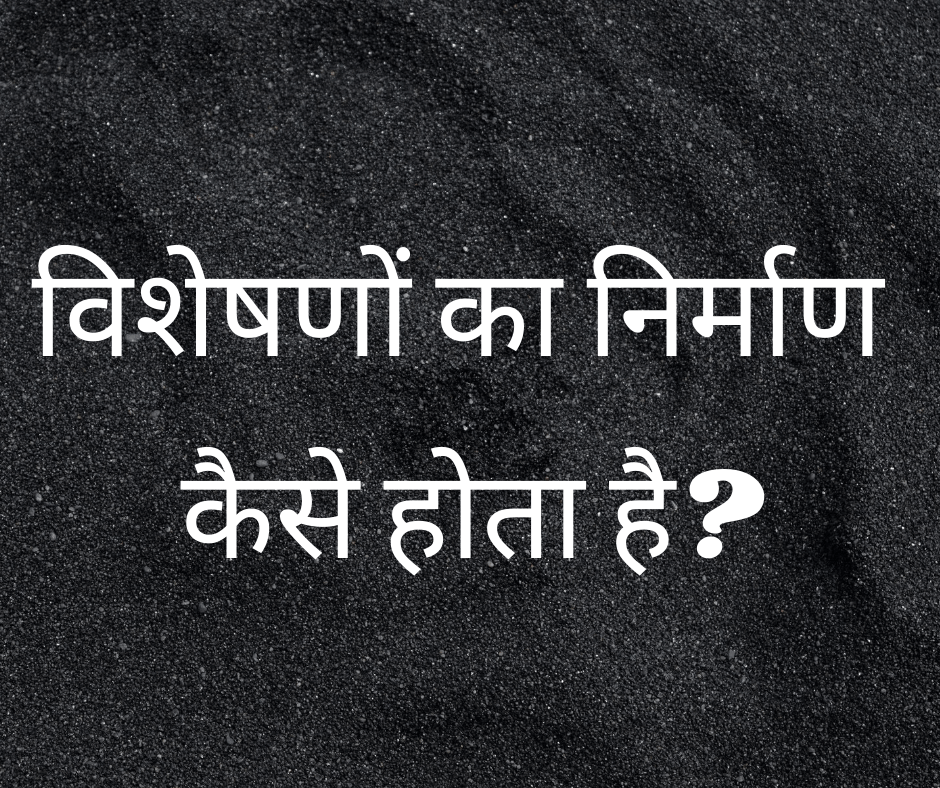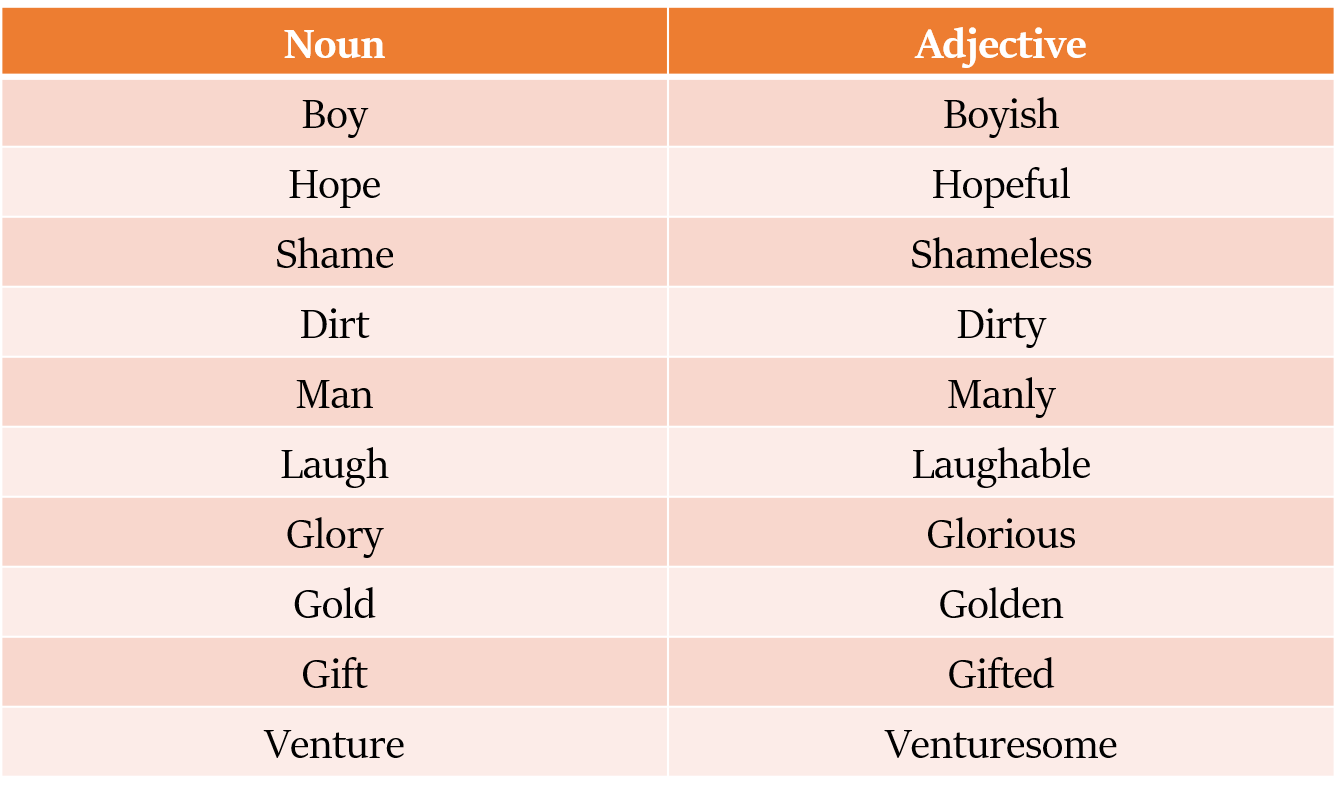विशेषणों का निर्माण कैसे होता है? (Formation of Adjectives)

Overview
इस लेख में हम अंग्रेजी के एक महत्त्वपूर्ण अध्याय के बारे में जानेंगे - Formation of Adjectives, in Hindi (हिंदी में)
 नोट
नोटइस अध्याय से सम्बंधित, अन्य विषयों के बारे में जानने के लिए आप हमारे निम्नलिखित लेख पढ़ सकते हैं:
इस लेख में हम अध्ययन करेंगे कि विभिन्न प्रकार के विशेषण (Adjectives) कैसे बनते हैं।
तुलना की डिग्री (degree of comparison) के आधार पर विशेषण तीन प्रकार के होते हैं:
- सकारात्मक या मूलावस्था डिग्री (Positive degree)
- तुलनात्मक या उत्तरावस्था डिग्री (Comparative degree)
- उत्तमावस्था डिग्री (Superlative degree)
आइए, सकारात्मक डिग्री (Positive degree) के विशेषणों से शुरू करें।
सकारात्मक डिग्री के विशेषणों का गठन (Formation of Adjectives of Positive degree)
विशेषण निम्नलिखित से बनते हैं:
- संज्ञाएं (Nouns)
- क्रिया (Verbs)
- अन्य विशेषण (Adjectives)
संज्ञा से बने विशेषण (Adjectives formed from Nouns)
कई विशेषण संज्ञा से बनते हैं।
formation of adjectives
क्रिया से बने विशेषण (Adjectives formed from Verbs)
कुछ विशेषण क्रिया से बनते हैं।
formation of adjectives
विशेषण से बने विशेषण (Adjectives formed from Adjectives)
कुछ विशेषण अन्य विशेषणों से बनते हैं।
formation of adjectives
विशेषण की उत्तरावस्था और उत्तमावस्था डिग्री का गठन (Formation of Comparative and Superlative Degrees of Adjective)
अब, आइए समझते हैं कि विशेषण की उत्तरावस्था (Comparative) और उत्तमावस्था (Superlative) डिग्री कैसे बनती हैं।
एक शब्दांश के विशेषण (Adjectives of one syllable)
एक शब्दांश (और कुछ एक से अधिक) के अधिकांश विशेषणों में, हम निम्नलिखित जोड़ते हैं:
- er Positive डिग्री में, Comparative डिग्री बनाने के लिए और
- est Positive डिग्री में, Superlative डिग्री बनाने के लिए।

formation of adjectives
लेकिन इस सामान्य नियम के कई अपवाद हैं।
अपवाद 1
जब positive degree का विशेषण e में समाप्त होता है, तो केवल r और st जोड़े जाते हैं।
formation of adjectives
अपवाद 2
जब positive degree का विशेषण 'y' में समाप्त होता है, और उससे पहले व्यंजन (consonant) आता है , तो 'er' और 'est' जोड़ने से पहले 'y' को 'i' में बदल दिया जाता है।
formation of adjectives
यदि 'y' से पहले कोई स्वर (vowel) मौजूद हो, तो केवल 'er' और 'est' को ही जोड़ा जाना चाहिए।
formation of adjectives
अपवाद 3
जब positive degree का विशेषण एक शब्दांश का शब्द हो, और एकल (single) व्यंजन में समाप्त होता हो, जिसके पहले लघु स्वर (short vowel) हो, तो यह व्यंजन 'er' और 'est' जोड़ने से पहले दोगुना कर दिया जाता है।
formation of adjectives
 नोट
नोटलघु या संक्षिप्त स्वर वो स्वर होता है, जो दो व्यंजनों के बीच होता है, यानी इस पैटर्न में: व्यंजन-स्वर-व्यंजन| उदा. pet, sad, आदि
अपवाद 4: अनियमित रूप (Irregular Forms)
कुछ विशेषणों के Comparative और Superlative रूप अनियमित रूप से बनते हैं (विशेषण के positive रूप से नहीं)।
formation of adjectives
दो या दो से अधिक शब्दांशों के विशेषण (Adjectives of two or more syllables)
दो या अधिक शब्दांशों (syllables) के विशेषणों की Comparative और Superlative डिग्री बनाने के लिए, सामान्य तौर पर हम positive रूप से पहले more/less और most/least लगाते हैं।
formation of adjectives
दो शब्दांशों वाले विशेषण जो केवल more/less और most/least के साथ उपयोग किए जाते हैं (या इनके साथ अधिक उपयोग किए जाते हैं), निम्नलिखित हैं:
कृदंत विशेषण (participle adjectives), यानी दो-शब्दांशों वाले विशेषण जो ing या ed में समाप्त होते हैं (जैसे pleased, worried, boring, surprised)
दो-शब्दांशों वाले विशेषण -ful और -less में समाप्त होते हैं (जैसे careful, useful, careless, hopeless)
कई अन्य दो-शब्दांशों वाले विशेषण (जैसे afraid, alike, alert, ashamed, alone, aware; cautious, certain, complex, confident, eager, exact, famous, foolish, formal, frequent, modern, recent)
लेकिन हमेशा की तरह इसके अपवाद भी हैं। वास्तव में, दो शब्दांशों वाले अधिकांश अन्य विशेषण (ऊपर सूचीबद्ध विशेषणों के अलावा) दो रूप ले सकते हैं।
अपवाद
कुछ विशेषण या तो 'er' और 'est' या more/less और most/least ले सकते हैं।
यहां ऐसे विशेषणों की एक सूची दी गई है: cruel, common, feeble, gentle, polite, simple, narrow, handsome, pleasant, stupid.
Aanya is politer/more polite than Mragank.
Meenakshi is the politest/most polite of them.
 एक चेतावनी
एक चेतावनीजब हम एक ही व्यक्ति के दो गुणों की तुलना करते हैं, तो हम हमेशा 'more + विशेषण (adjective)' का उपयोग करते हैं (न कि उनकी comparative या superlative डिग्री)
He is luckier than laborious. (गलत)
He is more lucky than laborious. (सही)
उत्तरावस्था या उत्तमावस्था रूपों के बिना विशेषण (Adjectives without comparative or superlative forms)
कुछ विशेषण ऐसे होते हैं जिनकी तुलना नहीं की जा सकती। इसलिए, इन विशेषणों के comparative या superlative रूप नहीं होते हैं।
उदाहरण के लिए: square, round, circular, perfect, excellent, eternal, universal, unique, extreme, major, minor, equal, interior, exterior, ulterior, empty, excellent, chief, entire, complete, final, last, triangular, eternal, everlasting, ideal, absolute, impossible and supreme.
इन विशेषणों का पहले से ही comparative या superlative अर्थ है। इसलिए, वे विरले ही -er/-est या more/less/most/least के साथ उपयोग किए जाते हैं।
This is a case of most extreme malnutrition. (गलत)
This is a case of extreme malnutrition. (सही)
She is the most unique character in this movie. (गलत)
She is a unique character in this movie. (सही)
This headset is more inferior to that. (गलत)
This headset is inferior to that. (सही)
अपवाद
हम जानते हैं कि कोई वस्तु अधिक वर्गाकार, अधिक गोल, अधिक परिपूर्ण (more square, more round, more perfect) नहीं हो सकती। लेकिन कुछ अपवाद हैं जहां हम उनका उपयोग करते हैं।
उदाहरण के लिए:
All ministers are equal but some ministers are more equal than others.
This is the most perfect specimen I have seen.
विशेषण जो केवल सकारात्मक और उत्तमावस्था डिग्री में उपयोग किये जाते हैं (Adjectives used in only positive and superlative degree)
कुछ विशेषणों में केवल positive और superlative डिग्री होती है। उनकी comparative डिग्री नहीं होती है।
आइए इनमें से कुछ विशेषणों को देखें।
formation of adjectives

अतिरिक्त पुस्तकें और उपकरण
यदि आप किताबों के माध्यम से सीखना पसंद करते हैं, या संदर्भ उद्देश्यों के लिए कुछ अच्छी अंग्रेज़ी व्याकरण किताबें चाहते हैं, तो आप हमारा यह लेख पढ़ सकते हैं|